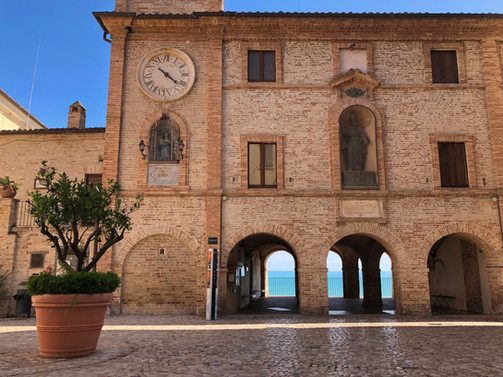Grottammare, Riviera delle Palme
- Mike
- Nov 3, 2023
- 4 min read
Updated: Sep 27, 2024

Elena’s love affair with Grottammare on the Riviera delle Palme goes back decades, mine only 8 years, but whenever we’re passing through southern Marche we try to make time for a day or two here.

Our actual beach time every year however is increasingly sacrificed to Elena’s insatiable appetite to explore when all I really want is one whole day on a sun lounger interrupted only by dips in the sea and a lunch of linguine alle vongole washed down with a bottle of the local Pecorino or Passerina wine.
Grottammare Alta
Grottammare, on the aptly named Riviera delle Palme, is one of those all-too-rare seaside towns in Italy that have retained a relaxed and very genuine atmosphere, neither too big or too small with a year round population of 16,000, nor particularly crowded outside of the peak summer weeks. It's also largely unspoiled by overbuilding along the seafront. For us it's in the same company as some of our other favorites we have written about like Castiglione della Pescaia and Talamone in the Maremma, Santa Maria di Castellabate in Cilento, Moneglia on the Riviera di Levante and Vieste on the tip of the Gargano promontory.
Grottammare Alta
After spending the summer of 1868 in Grottammare the Hungarian composer and pianist Franz Liszt was equally enamored with the resort and sang its praises in his thank you letter to his host, Count Fenili, as follows:
"L'azzurro mare, gli ameni colli verdeggianti, la dolcezza del clima e il profumo dei fiori e degli aranci formano una poesia pari alla celeste armonia dei suoni”.
One of the notable things that Grottammare has in common with many of our other favorite beach resorts is the presence of a much older section of town nearby, built higher up on a hill in a position that afforded better protection from the North African and Ottoman pirate raids that were a constant threat everywhere along the Italian coastline from 1500 to 1800.
The fortifications in Grottammare, consisting of the Torrione della Battaglia and the defensive walls, were constructed in the second half of the 16th century in direct response to a pirate attack from across the Adriatic in what is today the tiny country of Montenegro.

Grottammare Alta as it’s called, to distinguish it from the beach community, is not particularly elevated at about 400 feet but that’s enough to afford fabulous views along the coastline from the park at the top near the old castle or from the viewing area next to the restaurant Borgo Antico, a restaurant that seems to be living off its past reputation.
The old town these days is a peaceful and prosperous looking place that’s an easy walk from the lower town; the houses are all well-kept with nothing run down or abandoned and there’s plenty of places to eat. The autostrada is directly below the town in a tunnel carved through the rock so there’s no noise impact on the town at all.
At the center of Grottammare Alta is Piazza Peretti (above left) with it’s attractive 18th century brickwork and an arched loggia facing towards the sea. Half of the piazza in summer becomes an outside eating area for the restaurant Osteria dell’Arancio, a very well regarded place to eat according to many Italian commentators.

The old part of town is interesting enough but far as I'm concerned the beach and the seafront is what distinguishes Grottammare from so many other ho-hum resort towns along the Italian coastline.
Let's start with the the beach, which is a broad stretch of soft sand with none of the stones that cover many beaches in Italy, particularly along the Ligurian coastline or even further north in le Marche around the otherwise lovely town of Sirolo.
There's a barely perceptible slope down to the water and it's so shallow that once in the sea you can comfortably walk almost all the way out to the artificial rocks that form the breakwater to prevent beach erosion. The Italians take their summer beach holidays seriously and if a resort like Grottammare were to lose much of its sand in a winter storm the economic consequences would be severe.

One of the things that makes Grottammare so attractive is the paved promenade that extends for about 3 miles connecting the town seamlessly to San Benedetto del Tronto to the south and Cupra Marittima to the north. The path is between the beach and the road separated by palm trees and makes for a fantastic early morning walk or bike ride with the sun rising over the Adriatic.
The highlight of this stroll is without question the short section in the middle of Grottammare (photos below) past palms, flowering oleanders and well preserved Liberty style villas dating from around the turn of the 20th century. Like a short microcosm of the Viareggio promenade famous for its array of Liberty style architecture.
As Grottammare peters out the path continues north on its way towards Cupra Marittima. From this point onwards it is sandwiched between the railway line and the sea which is now lined with rocks rather than beaches.

We normally turn around at the 43rd parallel sign; having spent many years living very close to the same latitude in the American Mid-West it always amazes me how much more benign the climate is in this part of the 43rd parallel. If I were forced to pick a spot to live anywhere along this line as it circumnavigates the world then Grottammare would be it, certainly not Vladivostok or Milwaukee.
Finding a place to stay in Grottammare itself can be a challenge. The selection of airbnb apartments leaves a lot to be desired and there is an uninspiring choice of hotels. Our best stay in town over the years was probably at the Hotel Helvetia which is in an elegant 19th century Liberty villa about 800 yards from the beach. Otherwise we have preferred to stay in one of the many charming hilltop towns a short drive away like Ripatransone, Monteprandone or Acquaviva Picena.
Another way to gauge the vibrancy of an Italian town in the summer is to review their itinerary of concerts, exhibitions and festivals and on this score Grottammare does very well. It publishes a thick glossy 48 page handbook of all the events packed into a three month period from June to September, proving that this is a town that caters very well to its visitors.




















